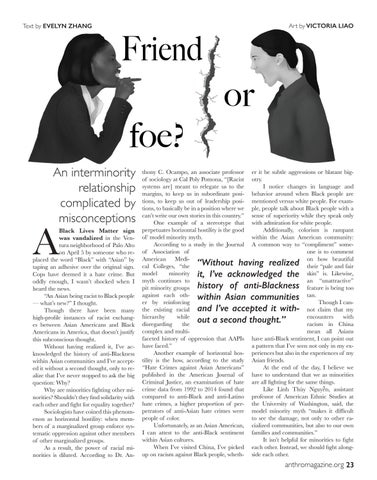Text by EVELYN ZHANG
Friend
foe? An interminority relationship complicated by misconceptions
A
Black Lives Matter sign was vandalized in the Ventura neighborhood of Palo Alto on April 5 by someone who replaced the word “Black” with “Asian” by taping an adhesive over the original sign. Cops have deemed it a hate crime. But oddly enough, I wasn’t shocked when I heard the news. “An Asian being racist to Black people — what’s new?” I thought. Though there have been many high-profile instances of racist exchanges between Asian Americans and Black Americans in America, that doesn’t justify this subconscious thought. Without having realized it, I’ve acknowledged the history of anti-Blackness within Asian communities and I’ve accepted it without a second thought, only to realize that I’ve never stopped to ask the big question: Why? Why are minorities fighting other minorities? Shouldn’t they find solidarity with each other and fight for equality together? Sociologists have coined this phenomenon as horizontal hostility: when members of a marginalized group enforce systematic oppression against other members of other marginalized groups. As a result, the power of racial minorities is diluted. According to Dr. An-
Art by VICTORIA LIAO
or
thony C. Ocampo, an associate professor er it be subtle aggressions or blatant bigof sociology at Cal Poly Pomona, “[Racist otry. systems are] meant to relegate us to the I notice changes in language and margins, to keep us in subordinate posi- behavior around when Black people are tions, to keep us out of leadership posi- mentioned versus white people. For examtions, to basically be in a position where we ple, people talk about Black people with a can’t write our own stories in this country.” sense of superiority while they speak only One example of a stereotype that with admiration for white people. perpetuates horizontal hostility is the good Additionally, colorism is rampant ol’ model minority myth. within the Asian American community: According to a study in the Journal A common way to “compliment” someof Association of one is to comment American Medion how beautiful cal Colleges, “the “Without having realized their “pale and fair model minority it, I’ve acknowledged the skin” is. Likewise, myth continues to an “unattractive” pit minority groups history of anti-Blackness feature is being too against each oth- within Asian communities tan. er by reinforcing Though I canthe existing racial and I’ve accepted it with- not claim that my hierarchy while encounters with out a second thought.” disregarding the racism in China complex and multimean all Asians faceted history of oppression that AAPIs have anti-Black sentiment, I can point out have faced.” a pattern that I’ve seen not only in my exAnother example of horizontal hos- periences but also in the experiences of my tility is the how, according to the study Asian friends. “Hate Crimes against Asian Americans” At the end of the day, I believe we published in the American Journal of have to understand that we as minorities Criminal Justice, an examination of hate are all fighting for the same things. crime data from 1992 to 2014 found that Like Lính Thủy Nguyễn, assistant compared to anti-Black and anti-Latino professor of American Ethnic Studies at hate crimes, a higher proportion of per- the University of Washington, said, the petrators of anti-Asian hate crimes were model minority myth “makes it difficult people of color. to see the damage, not only to other raUnfortunately, as an Asian American, cialized communities, but also to our own I can attest to the anti-Black sentiment families and communities.” within Asian cultures. It isn’t helpful for minorities to fight When I’ve visited China, I’ve picked each other. Instead, we should fight alongup on racism against Black people, wheth- side each other.
anthromagazine.org 23




















